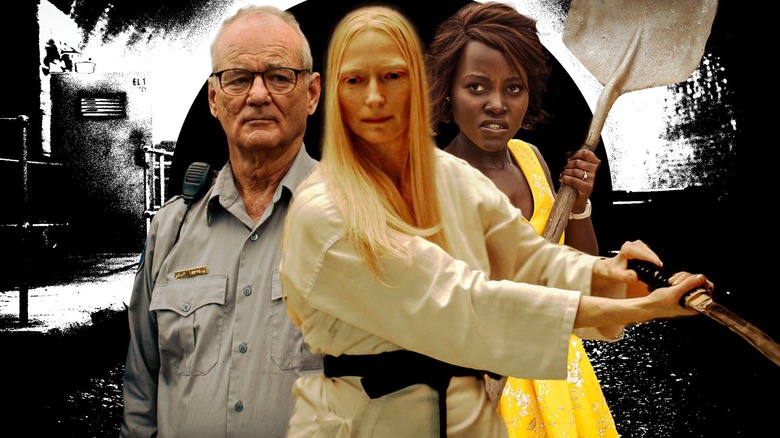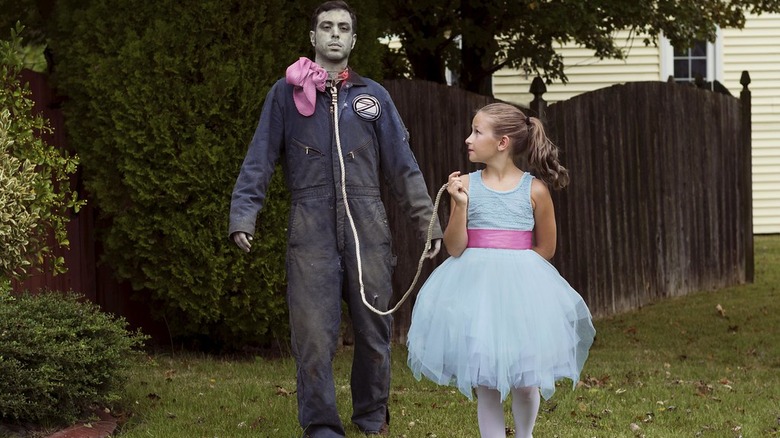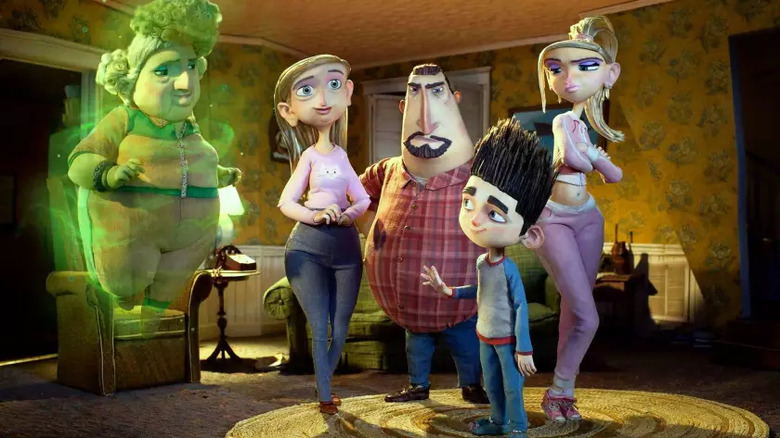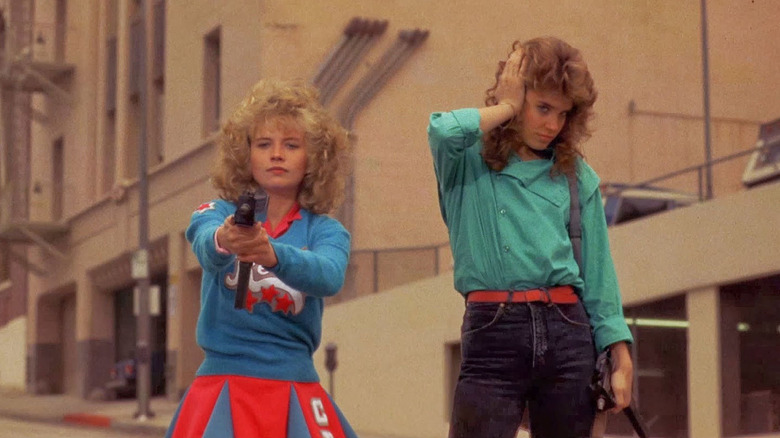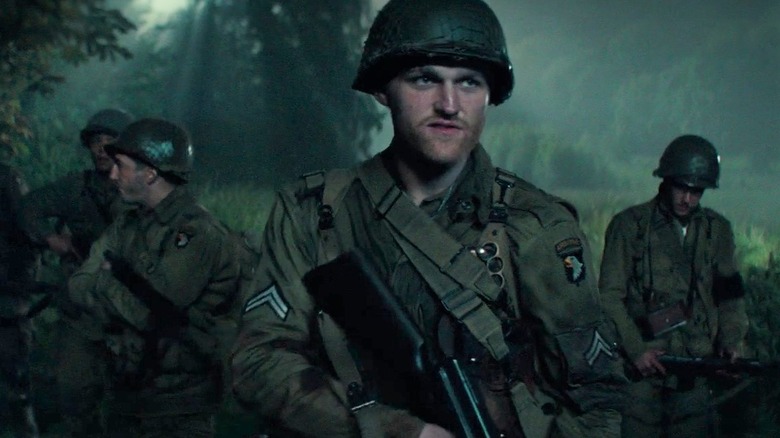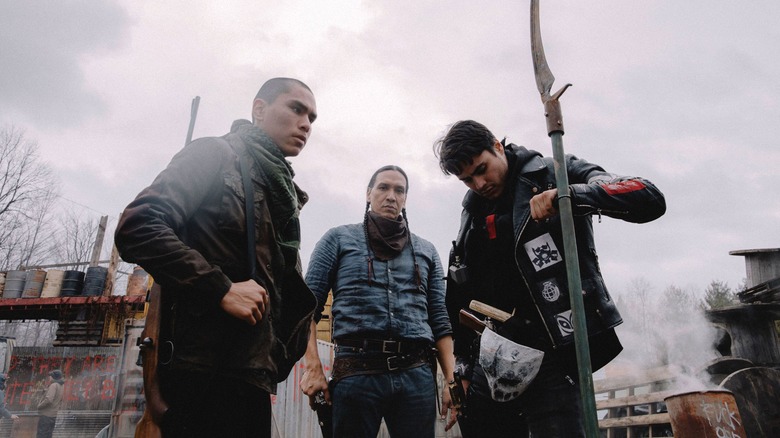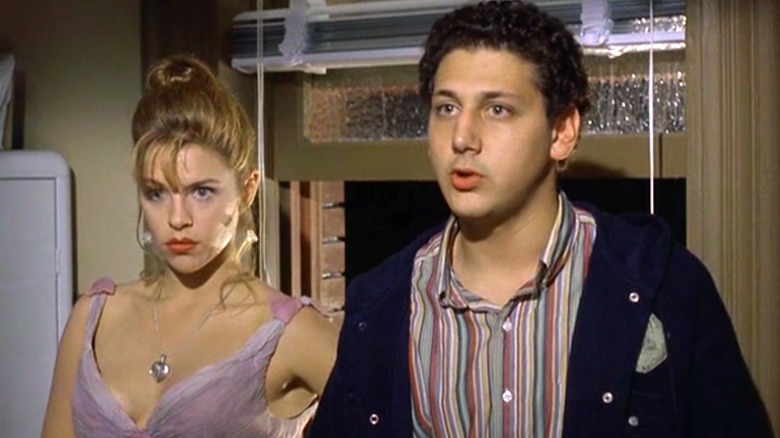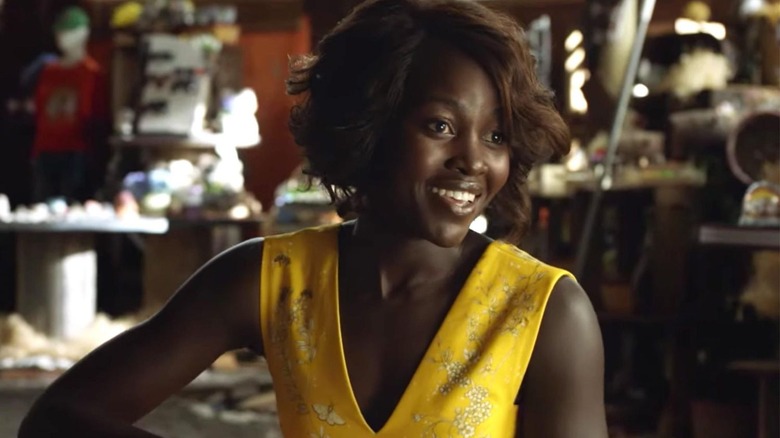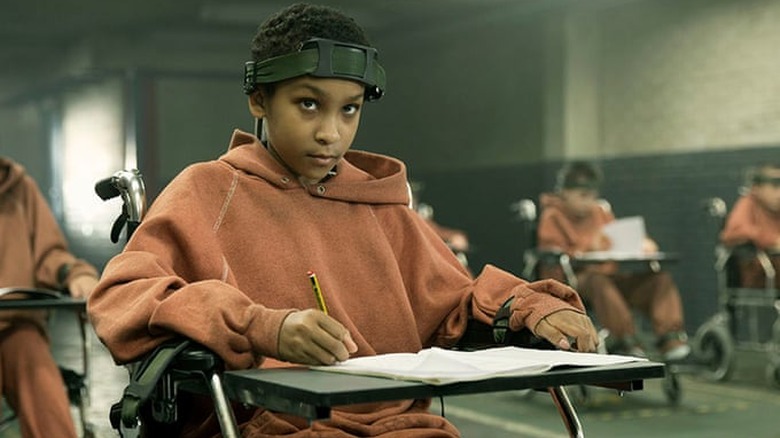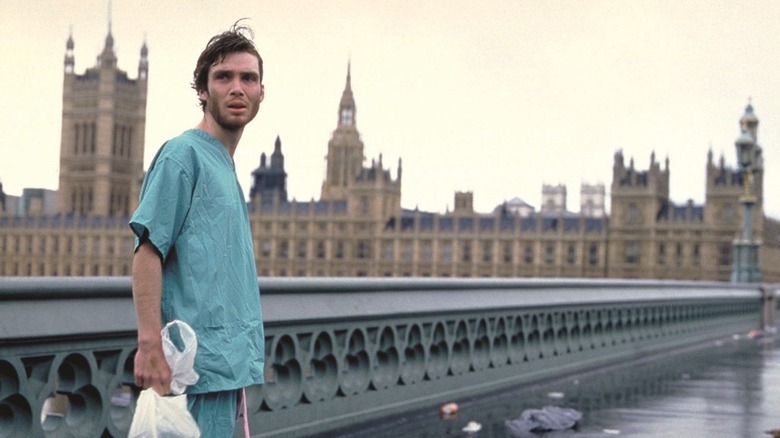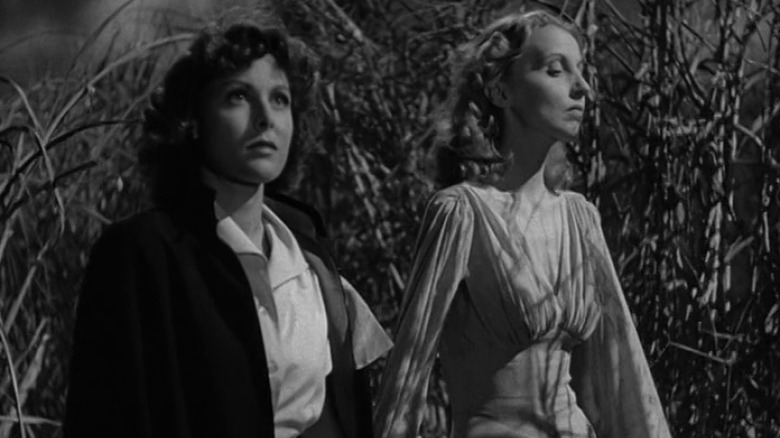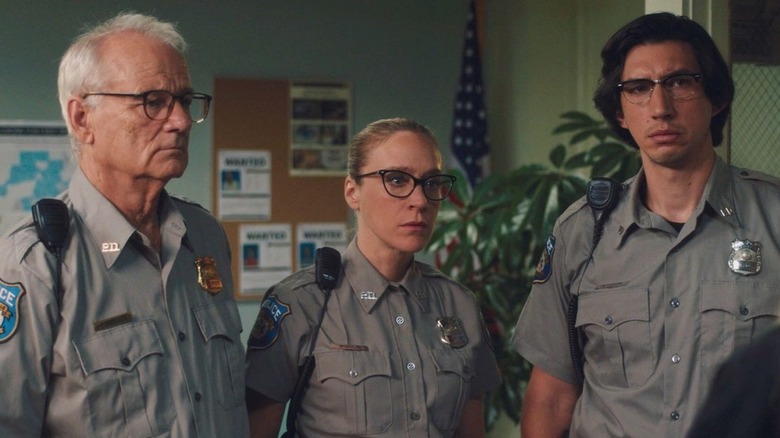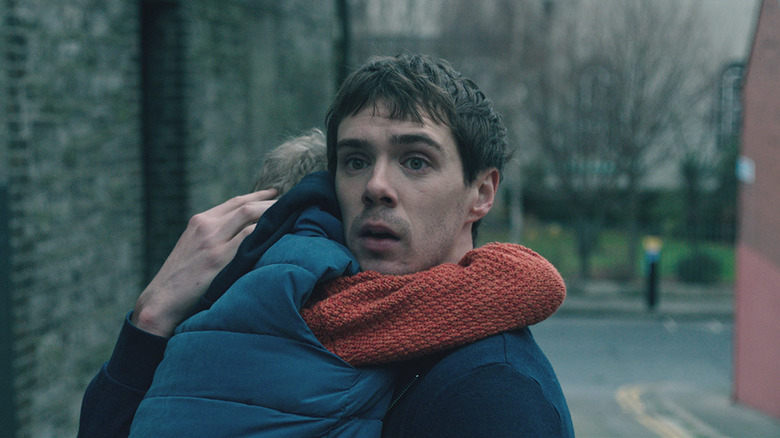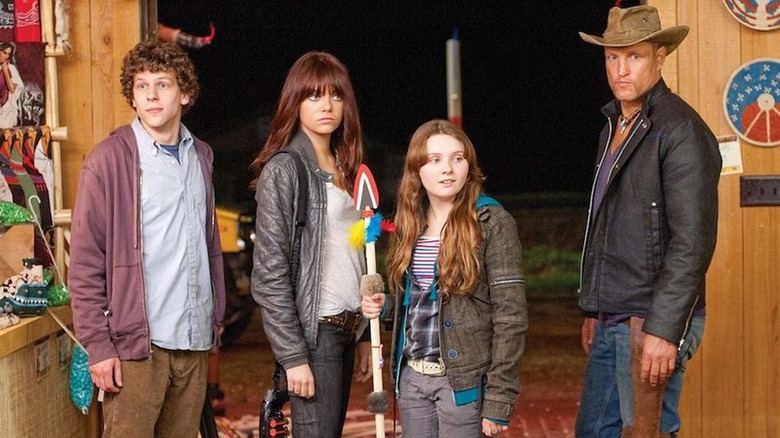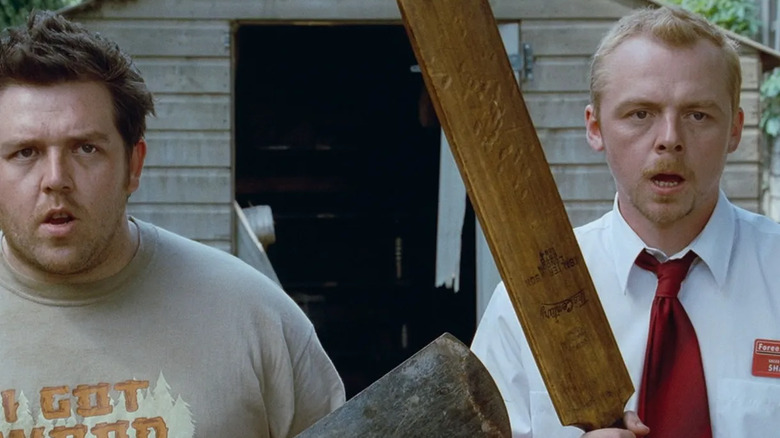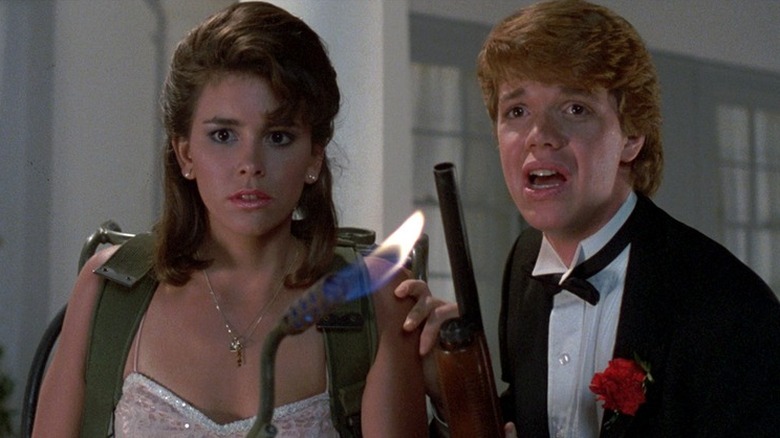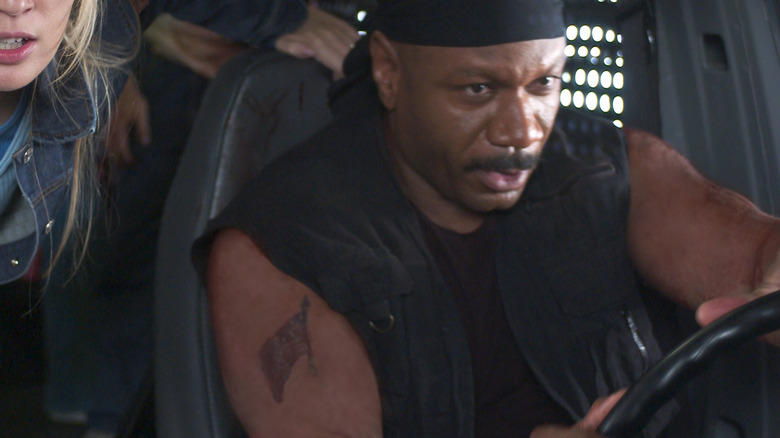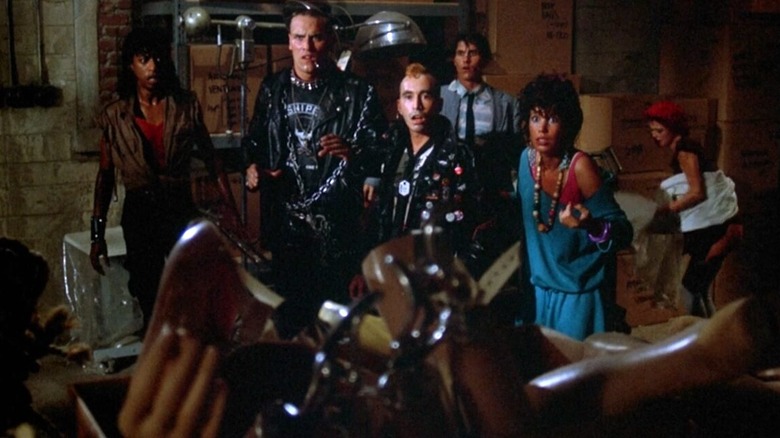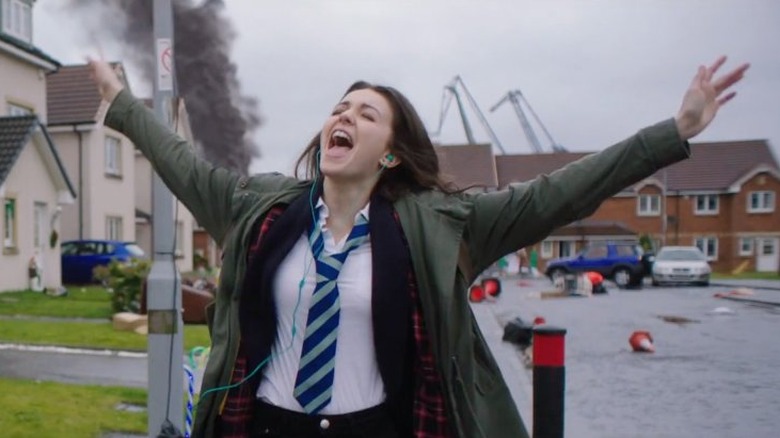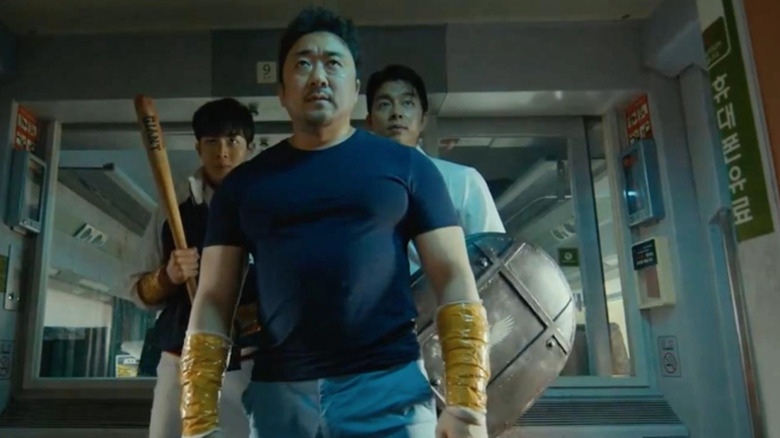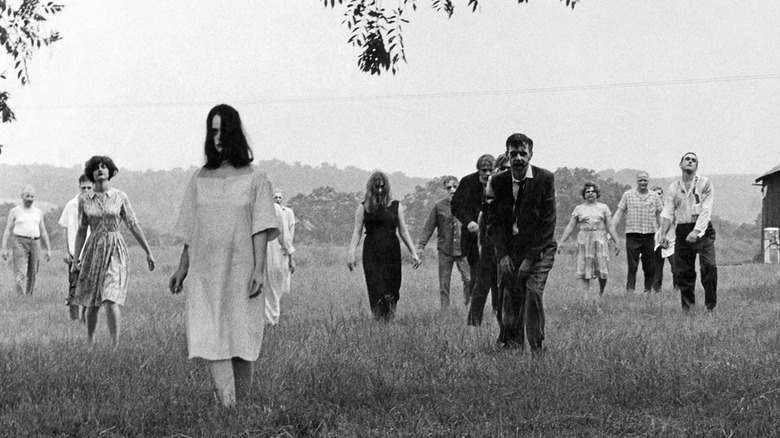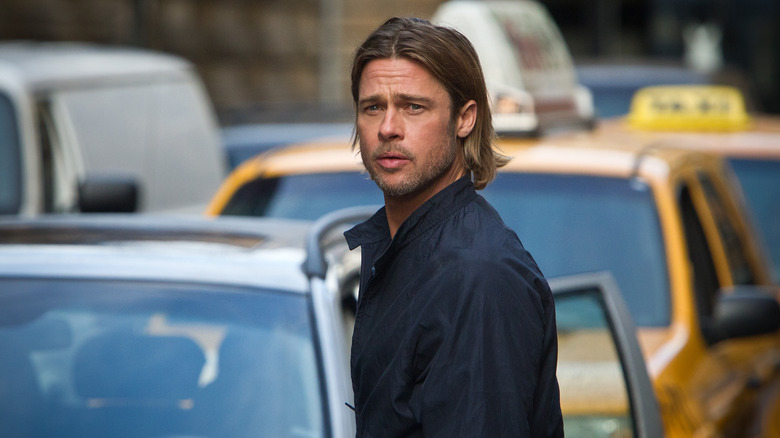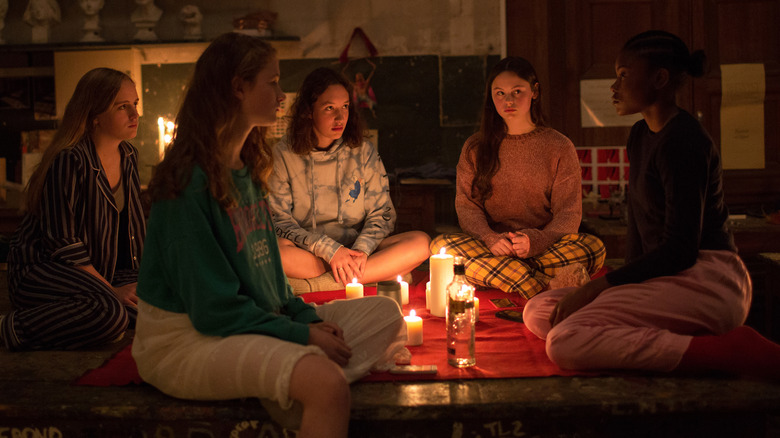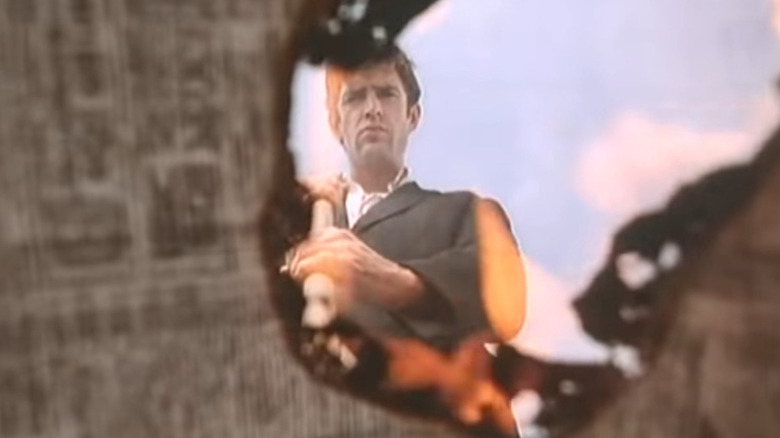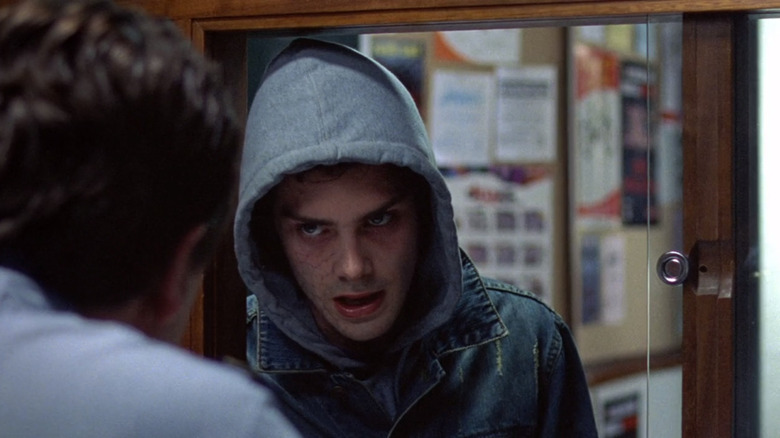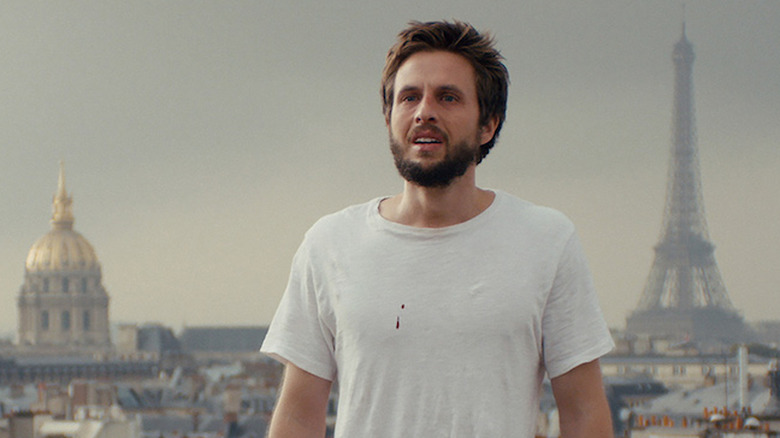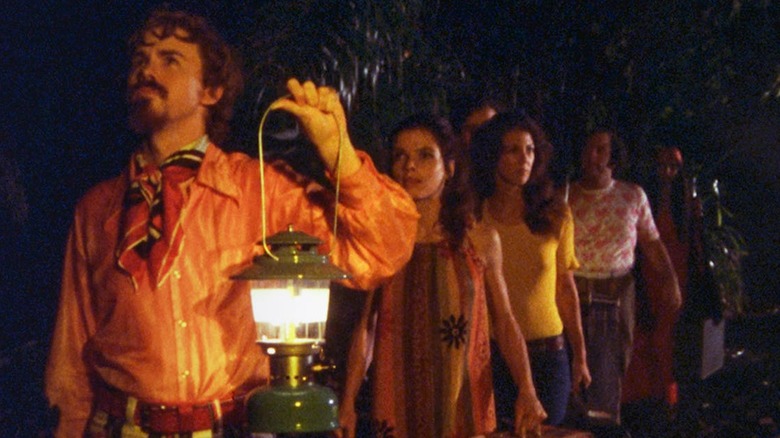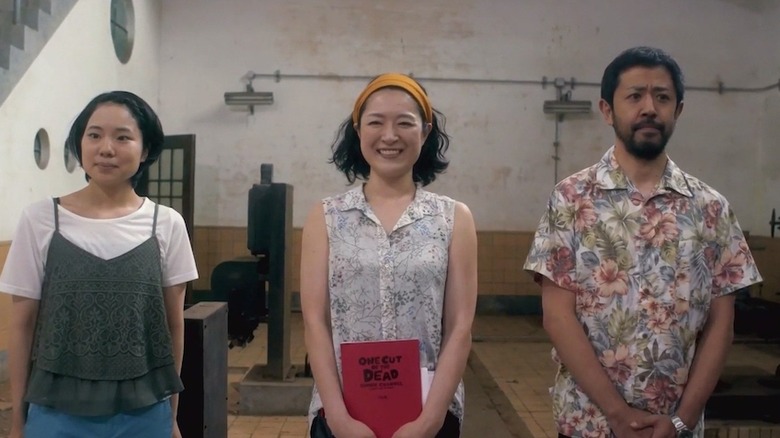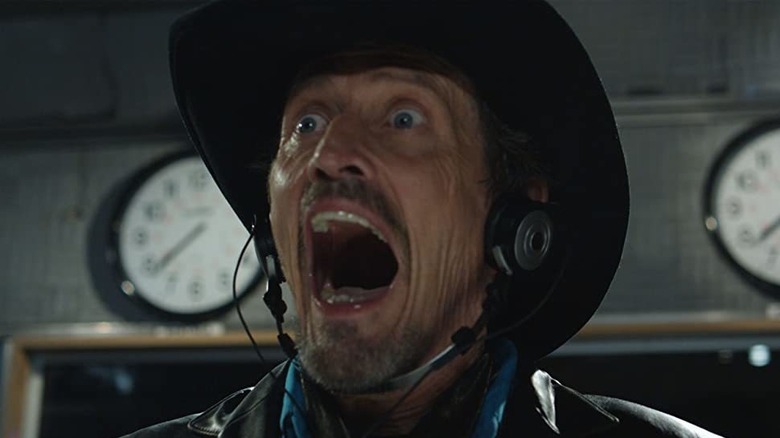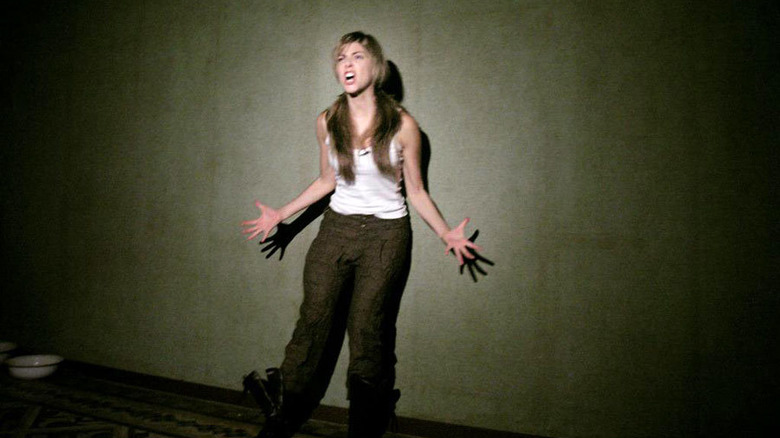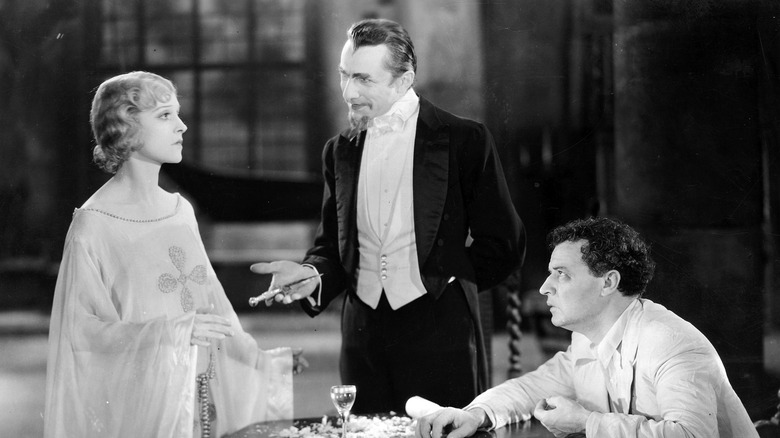The 30 Best Zombie Movies Of All Time
The zombie film takes up a lot of real estate in the horror genre. It ebbs and flows in terms of popularity, like anything else, but it always maintains a foothold, which speaks to how much audiences connect with the concept. Although the zombie genre has lots of tropes and general "rules," there's so much that a filmmaker can do with these brain-hungry members of the undead.
After all, horror is a genre that's particularly adept at repackaging social fears and political anxieties as seemingly simple stories, and the zombie film stands out as a particularly potent vehicle for social commentary. The possibilities for subtext are virtually limitless, and zombies allow a filmmaker an unusual amount of creative leeway, if they're inclined to take it. Thus, the genre is surprisingly varied, and mired with unexpected depth. Just like any good horror movie monster, when it comes to zombie films, there's so much more lurking underneath the surface.
Fido
On the face of it, "Fido" is just bizarre — and for a genre in which the dead walk the earth and eat human flesh, that's saying something. It operates in a strange '50s-esque universe where zombies exist, but are controlled by ZomCon collars that inhibit their cravings so well that they're kept by many families in an uneasy role that falls somewhere between servant and pet (the matter-of-factness with which this society has simply accepted the idea of zombies in their midst is equal parts jarring and hilarious).
In "Fido," a young boy named Timmy befriends his family's zombie, Fido (Billy Connolly), until Fido's collar malfunctions and he accidentally attacks the next door neighbor, setting off a zombie outbreak in their quiet suburban neighborhood. There's an argument to be made that "Fido" is little more than a one-joke movie, but it's hard to hold that against it when it commits to that one joke so thoroughly, and with such a quirkily endearing sense of humor.
ParaNorman
A child-friendly zombie film feels like an oxymoron, but that's exactly what "ParaNorman" is. A suitably spooky stop-motion picture from Laika, "ParaNorman" revolves around the adventures of Norman Babcock, a boy who, like Haley Joel Osment in "The Sixth Sense," sees dead people everywhere. The ghosts come with their own sets of problems, some things get out of hand, and long story short, a long-dead, persecuted witch ends up summoning an army of zombies, who promptly attack the townspeople (as zombies are wont to do).
Despite its rather grim narrative, "ParaNorman" is a vibrantly alive film, full of energy and purpose. And also, not for nothing, but "ParaNorman" deserves some credit for featuring the first openly gay character in a mainstream children's animated film (a fact that Disney should likely mull over the next time it wants its PR team to spin a yarn about debuting the company's "first gay character" for the 16th time in five years).
Night of the Comet
You know how full moons are known for bringing out people's weird and unstable sides? Apparently, comets are worse. In "Night of the Comet," the Earth passes through the tail of a comet, and the lingering space material has some unexpected consequences, including reducing most of the population to red dust and turning the rest into zombies. Only people who happened to be protected by a steel barrier are safe: a girl sleeping in her family's shed after a fight with her stepmother, for example, or a pair of lovers who spent the night in a steel-lined projectionist's booth.
"Night of the Comet" is notable for its powerful young female protagonists, who take on the zombie apocalypse with hidden reserves of strength and determination. It's a B-movie that never mocks its subjects, and has earned the cult following it has amassed in the years since its initial release.
Overlord
"Overlord" is not a complicated movie. It's basically just, "What if World War II, but with zombies?" That said, it stands out as one of the most enjoyable and entertaining zombie films of the past decade, in part because the concept of zombies in historical settings hasn't been explored nearly enough.
In the days leading up to the Allied invasion at Normandy, a group of American soldiers are dropped behind enemy lines only to discover (what else?) the zombified test subjects of secret experiments. "Overlord" evokes not just tropes from zombie films, but also action films, specifically combat dramas. These influences are a natural fit for one another, creating an environment in which the zombie apocalypse is fought like an actual war. The melding of these two genres gives "Overlord" a unique tone, and even if it's not the best zombie film ever made, it's a fresh enough concept to earn the movie at least a little bit of credit.
Blood Quantum
Historically, the concept of "blood quantum" refers to the somewhat controversial practice of defining a person as Indigenous based on what fraction of their heritage comes from an Indigenous group. Blood quantum was used to establish legally quantifiable racial groups in North America, and many American Indian tribes utilize it as a benchmark for membership.
The film "Blood Quantum" is an interesting twist on the practice, exploring what happens when a specific tribe discovers that it's immune to a plague that reanimates people, turning them into zombies. Their white neighbors invade the reservation, seeking protection at the expense of the Indigenous people who already live there, as per usual.
"Blood Quantum" is a grisly film that follows many of genre's tropes (including, but not limited to, the character who attempts to hide that they've been bitten by a zombie with devastating consequences), but it also comes with intriguing sociopolitical commentary that represents a new creative direction for Indigenous Canadian filmmaking.
My Boyfriend's Back
"My Boyfriend's Back" might be something of an acquired taste; it certainly doesn't show up often when people rank their top zombie films. But they don't know what they're missing, because "My Boyfriend's Back" is an absolutely ridiculous delight.
A teenage boy has been in love with one of his classmates since the first grade, and comes up with the idea of impressing her by foiling a pretend robbery at the gas station where she works. Problem one: an actual robber turns up, doesn't take kindly to the interference, and shoots him. Problem two: the boy somehow manages to fight his way out of the graveyard and back among the living, albeit slightly more dead than they all might have hoped. Problem three: he is starting to fantasize about eating some of his classmates.
An exercise in absurdist humor, everyone takes the fact that this kid is a member of the walking dead in stride. If anything, they're annoyed that he's making such a big thing out of it, expecting special treatment just because he's a zombie. And look, if nothing else, "My Boyfriend's Back" is an opportunity to see a very young Philip Seymour Hoffman and Matthew McConaughey in one of their first film appearances.
Little Monsters
A lot of actors struggle trying to figure out how to follow up an Academy Award win — after all, there's lots of pressure to pick exactly the right project. Not Lupita Nyong'o. In the six years after taking home Oscar gold for "12 Years a Slave," she's been featured in (amongst other things) "Star Wars," "Black Panther," and this underrated little zombie comedy, "Little Monsters."
Nyong'o stars as a schoolteacher whose field trip to a local farm goes somewhat awry when it turns out that a bunch of zombies have escaped from a testing facility, wreaking havoc on the formerly peaceful fields and pens. Together with a failed musician (Alexander England) and a children's television personality named Teddy McGiggles (played by Josh Gad, because of course), the teacher must defend the children in her charge from the flesh-eating hordes. And it's honestly pretty cute! That's probably not the most obvious description of a zombie movie, but look, "Little Monsters" is what it is.
The Girl With All the Gifts
Children in zombie movies are usually utilized for additional shocks. It's fundamentally disturbing to see a dead child on screen, let alone one who happens to be gnawing on someone else's detached femur. But it's relatively rare to see a child as the protagonist in a zombie film, which is one of the reasons that "The Girl With All the Gifts" is so unique.
In it, Sennia Nanua stars as Melanie, a special little girl who represents hope for the future of humanity in the face of a parasitic fungus that turns ordinary people into "hungries" who crave ... well, you can probably guess. As a second-generation hungry, Melanie has a thirst for human flesh, but is also capable of logic, reason, and empathy; she's a hybrid who could bridge the gap between humanity and the hungries, resulting in a gripping, markedly different interpretation of the traditional zombie film.
28 Days Later
You remember when COVID-19 first became a thing and there was a news story about that guy out on his boat in the middle of the Pacific who went weeks, maybe even months, without realizing that the entire world had changed? That's sort of what "28 Days Later" is like. It follows a man (Cillian Murphy, in one of his first film roles) who wakes up from a coma 28 days after a deadly virus causes everyone who is infected to turn into a rage-filled, bloodthirsty zombie. What must it be like to miss the initial zombie onslaught, and be catapulted into a strange new world unlike anything you had ever even imagined?
The desolate shots of the streets of London give "28 Days Later" an eerie, deeply unsettling vibe; for there to be so few people out in one of the most active and populated cities in the world is more of an indication that something is unmistakably wrong than anything else could be.
I Walked With a Zombie
"I Walked With a Zombie" is one of the original zombie films, but it isn't about the living dead walking the earth, desperate to nosh on some human brains. Instead, its zombie is a young woman who is seemingly catatonic, except at night when she wanders her husband's Caribbean estate, entranced. This is the zombie before George Romero got his hands on it, a tool of voodoo and black magic, revenge and power. These elements of control tie the older concept of a zombie inextricably to slavery, a fitting theme for a narrative set on a sugar plantation.
Released in 1943, "I Walked With a Zombie" was directed by Jacques Tournier, a French filmmaker known for the string of low-budget horror films he created throughout the '40s. This one is special, though — it has an ethereal beauty that transfixes audiences even as it repels them. Atmospheric and poetic, "I Walked With a Zombie" remains popular among horror audiences to this day.
The Dead Don't Die
So there's the zombie parody movie — you know, something like "Shaun of the Dead" — and then there's "The Dead Don't Die," which is so strange and self-referential and utterly meta that it circles well past parody and becomes its own, bizarre thing. Adam Driver, Chloe Sevigny, and Bill Murray star as a trio of small town cops bemused by the presence of a zombie outbreak in their community.
"The Dead Don't Die" has a unique sense of humor that may not be to everyone's taste, but it deserves praise for how committed it is to its own brand of storytelling. There are the traditional zombies, but there are also aliens, characters who have read the script to the movie that they're in, and Adam Driver riding around in a comically small Smart car (the keys to which, by the way, are held on a Star Wars keychain, because at this point why not just go for it?).
The Cured
The zombie film has long operated as a reflection of social anxieties, specifically around infectious disease. There's a reason why one of the key tenets of the zombie mythos is the fact that, if you get bitten by a zombie, you become one. But "The Cured" is one of the rare films that actually explores the concept of zombification of a disease. If it's a medical condition, there's a possibility that science could find an antidote. And that opens up an entirely new can of worms: How do you reintegrate former zombies into a traumatized society that has been trained to view them as a threat?
Here, Elliot Page plays Abbie, a young widow who provides a safe haven for her brother-in-law, an ex-zombie grappling with memories of his past. "The Cured" delves deep into prejudice and mob mentality; if you are part of this distinct group of individuals, people will always be watching you with suspicion, waiting for you to break the law or, here, start craving human flesh again.
Zombieland
What's so refreshing about "Zombieland" is that it envisions a zombie apocalypse with people in it who seem like they've seen at least one zombie movie before. Jesse Eisenberg is perhaps not the person you'd most expect to survive a "The Walking Dead" scenario, but it turns out that he's actually pretty good at keeping himself alive. His secret? An extensive list of rules, some common sense, some born out of experience in the field, that help him to avoid some of the more obvious pitfalls in zombie combat and evasion.
But Eisenberg's Columbus has spent the entire post-apocalypse by himself, and when he inadvertently teams up with Tallahassee (Woody Harrelson), Wichita (Emma Stone), and Little Rock (Abigail Breslin), things become significantly more complicated. The four lead characters have great chemistry together, and amidst the quirky, iconoclastic violence, there are moments of genuine heart. Oh, and there's zombie Bill Murray. Can't beat that.
Shaun of the Dead
"Shaun of the Dead" is the premier horror parody, a send-up of zombie movies that would teach all the other jokesters how to properly satirize a genre. Directed by Edgar Wright and starring Nick Frost and Simon Pegg, "Shaun of the Dead" is the first in what would come to be called the Cornetto trilogy, a series of three movies that would each poke fun at a different genre.
Pegg and Frost play a pair of Englishmen caught unawares by the impending zombie apocalypse and, upon discovering the extent of this unforeseen calamity, seek refuge at their favorite local pub. "Shaun of the Dead" lovingly references the staples of the zombie subgenre, while at the same time featuring Pegg and Frost's uniquely irreverent style of humor. It became a hit on both sides of the pond — ironically, it was released just two weeks after Zack Snyder's "Dawn of the Dead."
Night of the Creeps
Framed like a classic '50s science fiction B-movie, "Night of the Creeps" manages to be both zombie horror and alien sci-fi. Basically, there are these slug-like alien creatures that slither into the ears, noses, and mouths of their victims, turning them into bloodthirsty zombies. They begin to infect a college campus, where our hero Chris (Jason Lively, older brother to Blake Lively) has to do battle with them to protect and impress his new love interest.
"Night of the Creeps" absolutely did not do well when it first came out, but audiences at the time didn't really understand what it was trying to do. Released in 1986, after a long string of slashers and monster flicks dominated the horror landscape, this was an homage to earnest horror movies built to be seen at a drive-in. There has since been a reevaluation of its charms, and "Night of the Creeps" has earned itself a respectable little cult following.
Dawn of the Dead
Realistically, every single one of George Romero's zombie films could appear on this list. But the 2004 remake of his "Dawn of the Dead" deserves special consideration, in part because it's a remake of a beloved zombie film that is actually good (and, if you ask some horror fans, potentially better than the original).
When the zombie apocalypse begins, a group of strangers take refuge in an abandoned mall, finding brief, fleeting security in their cooperative efforts and the safety their commercial fortress seems to provide. The characters are all immediately engaging, even the ones that you're desperately hoping will get eaten first (Ty Burrell as Steve Markus, we're looking at you), and they all seem to have more personality than one might expect from an ensemble cast in a zombie flick. A collaboration between future superhero stalwarts Zack Snyder and James Gunn, "Dawn of the Dead" deserves to be here if only for the brutally shocking opening scene, during which the zombie attacks begin in earnest.
Return of the Living Dead
There are zombie movies that are legitimately terrifying. "Return of the Living Dead" isn't one of them. And yet, it earns a spot here because it is pure campy chaos — honestly, there's an entire subsection of horror that is beloved because it isn't afraid to be ridiculous.
After two working-class stiffs at a medical supply warehouse accidentally crack open an ominous-looking government-issued barrel, they release a gas that reanimates the dead, turning perfectly ordinary corpses into flesh-eating monsters. The practical effects in "Return of the Living Dead" are surprisingly inventive, and the film has a lot of fun with the decision to have these zombies turn out to be a little more intelligent than your slow-moving, groaning alternative. They even speak (if only to say, "brains," and to philosophically explain why they are so insistent on eating brains); at one point, they get really greedy and lure an entire police squadron over, only to make a meal out of them. "Return of the Living Dead" is goofy, absurd, and so much more enjoyable than it has any right to be.
Anna and the Apocalypse
What is there to say about "Anna and the Apocalypse?" It's an utter gem. There's nothing else like it. Listen: this is a high school rom-com zombie Christmas musical, and it deserves to be embraced by the entire world.
In a small Scottish town, Anna's (Ella Hunt) conventional coming-of-age story is disrupted when her classmates and neighbors begin to be attacked by zombies, and she and her friends have to team up to fight them off. The songs are catchy, the acting is surprisingly good, especially considering that the ensemble cast was composed largely of unknown performers, and there's a quirky, intensely likeable sense of humor that permeates the entire proceedings. And if that weren't enough, there are parts of "Anna and the Apocalypse" that make you legitimately feel things. It's an instant classic, and once enough people have caught onto it, it'll occupy that same Halloween-Christmas space that "Nightmare Before Christmas" has dominated for far too long.
Train to Busan
"Train to Busan," a South Korean horror film directed by Yeon Sang-ho, is a double whammy. It's not just a zombie movie. It's a "trapped in a confined space with zombies" movie, which is infinitely more terrifying than your standard garden-variety setting. The traditional zombie film often involves some sort of temporarily safe space where our heroes can take refuge, barricading the doors and windows with lumber that always seems to be on hand.
But where do you go on a train? Where can you hide? "Train to Busan" is an intelligent horror film, willing and able to tackle social commentary in between its gruesome killings. Packed with engaging characters and plenty of action, "Train to Busan" was a massive success both in its native South Korea and abroad. And, in proper zombie blockbuster fashion, it even spawned its own wildly inferior sequel: 2020's "Peninsula."
Night of the Living Dead
It would be a crime of unprecedented proportions not to include "Night of the Living Dead," the granddaddy of the modern zombie film, at the top of this list. The zombies we see here are reanimated corpses thirsting for human flesh, unlike previous incarnations of zombies, which were the dead brought back to life to serve an earthly master. The latter is inextricably linked to Caribbean culture, but the former is not without its racial connotations.
Unusually for 1968, the level-headed, authoritative leader of the group at the farmhouse is played by Duane Jones, a Black man, who, significantly, survives the zombie horde only to be shot on sight by a white militia. But beyond that, "Night of the Living Dead" defines the concept of the zombie for all the films that would come after it. The zombies ambling towards the farmhouse are not frightening because of their power or strength, but because of their inevitability. You can fight off one zombie, you can maybe fight off 10, but if one gets a single, solitary bite in, you're finished.
World War Z
Based on the best-selling novel of the same name by Max Brooks, "World War Z" provides an overview of a global battle against the rise of zombies. Whereas the book takes a holistic approach, featuring short vignettes from different characters to explore how the zombie apocalypse globally impacted humanity, the film narrows its focus. "World War Z" follows former United Nations researcher Gerry Lane (Brad Pitt), who becomes determined to find a cure for the public health crisis. Although "World War Z" loses something in deviating so dramatically from the uniqueness of the source material, it is nonetheless a compelling addition to the zombie genre.
Tasha Robinson of The Dissolve put it best when she wrote, "The film doesn't hold together in any rational way, but it still has a lingering emotional power." It may not have been an unmitigated hit, but it was successful enough that there were rumblings of a sequel — albeit one that has been stuck in pre-production chaos for years and is unlikely to see the light of day (via Film Stories).
Zombi Child
You rarely encounter a zombie movie attempting to be arthouse cinema — but in the hands of acclaimed French director Bertrand Bonello, "Zombi Child" does just that. The film revolves around a teenage girl named Mélissa (Wislanda Louimat) who makes friends at her new French boarding school after her peers discover her family's background in voodoo. "Zombi Child" cuts between its present-day narrative, as the girls get in way over their heads after performing a voodoo ritual, and the mysterious resurrection of a zombie slave decades earlier in Haiti.
Eerie and thought-provoking, "Zombi Child" is as much a traditional horror film as it is a thorough examination of the legacy of French colonialism in the Caribbean. Andrew Lapin of NPR applauded the film's willingness to approach the zombie trope in a different way, writing, "Haiti's rich history of revolution and rebirth is still in want of filmmakers willing to take it seriously. But at least this one returns the undead to their roots before they themselves were colonized."
Cemetery Man
Life isn't easy as a cemetery caretaker — especially when you keep trying to tell people that the dead are rising and no one believes you. That's the plot of "Cemetery Man," a quirky horror comedy starring Rupert Everett as the custodian of a graveyard in Italy. A surreal cult film with a bizarre sense of humor, "Cemetery Man" blends Francesco Dellamorte's (Everett) efforts to hunt the zombies who continually emerge from the grounds of his cemetery and his many puzzling sexual encounters with women in town.
Sadly, its comedic stylings and lack of a coherent narrative may not be for everyone. But there's enough to like here to earn "Cemetery Man" a significant following among horror enthusiasts. Among its supporters is Drew Dietsch of Bloody Disgusting, who praised its ability "to balance two very disparate tones: over-the-top zombie comedy and a dreamy arthouse mood. These seem like they'd be constantly clashing with each other, but [director Michele] Soavi casts a spell that carries throughout the entire movie."
Boy Eats Girl
Tapping into the indie teen romance genre that was incredibly popular in the mid-2000s, "Boy Eats Girl" is a charming update of "My Boyfriend's Back" — albeit without that film's 1990s absurdist sense of humor. It stars David Leon as Nathan, an Irish teenager who is quietly pining for his best friend Jessica (played by Samantha Mumba, another 2000s stalwart) when he accidentally dies by hanging.
Nathan's horrified mother successfully brings him back to life, but with the unintended side effect of having a taste for human flesh. Although it's far from an original take on zombies, blending horror elements with teen drama is an almost universally winning formula. "Boy Eats Girl" is a likable contribution to the subgenre.
If you or someone you know is struggling or in crisis, help is available. Call or text 988 or chat 988lifeline.org
The Night Eats the World
Similar in some ways to "28 Days Later," "The Night Eats the World" revolves around a young man (Sam, played by Anders Danielsen Lie) who wakes up to discover zombies have taken over Paris. But where most zombie movies lean heavily on their action sequences, "The Night Eats the World" is much quieter and more meditative. Yes, zombies are terrifying. (No one wants to have their brains eaten, after all!) But the horror element that comes through best in this film is the unbearable feeling of isolation from knowing that you are entirely alone, surrounded by creatures who were once people.
Due to this approach, "The Night Eats the World" manages to feel fresh — despite the fact that it's mining an extremely saturated subgenre. Alex Hudson of Exclaim! put the film's narrative strengths best, writing, "Zombies might not be all that scary, but being trapped with your own thoughts is terrifying."
Children Shouldn't Play With Dead Things
Look, sometimes you want your zombie movies served with a side of intellectual pondering. Other times, you just want them to bring on the brains. "Children Shouldn't Play With Dead Things" falls firmly into the latter category — it's a simple, schlocky zombie film with no allusions about being a great, thought-provoking work of art. Still, there's a note of cleverness to the proceedings that separates it from every other B-movie trying to capitalize on the subgenre. The fact that it has what might be one of the greatest zombie movie titles of all time speaks in its favor.
Bob Clark (later known for his work on "Black Christmas") directed "Children Shouldn't Play With Dead Things" on a shoestring budget over the course of two weeks. The story follows a troupe of actors who land on an island off the coast of Florida. Led by their charismatic director, they perform a ritual to raise the dead. A lot of the movie is hokey and dated. But if nothing else, it deserves credit for its memorable final shot — an unexpectedly chilling moment where the zombies board the troupe's sailboat.
One Cut of the Dead
There's a self-aware cleverness to "One Cut of the Dead" that makes it instantly charming, despite its low-budget look. The essential premise is it's a film-within-a-film. Initially, we watch what appears to be a cheesy, low-budget horror movie, only to pull the perspective wide about a quarter of the way into the runtime. We then learn we're following a crew of intrepid filmmakers attempting to cobble together a live, one-take zombie flick.
While we get the familiar zombie tropes in the film's first half, the rest of "One Cut of the Dead" is devoted to showcasing what goes into a production like this. Frenzied crew members practically contort themselves to keep the show going. Meagan Navarro of Bloody Disgusting praised its inventiveness, writing, "Shinichiro Ueda's zombie comedy is one that purposefully pretends to offer familiar zombie schlock only to rip the rug out from under us in an innovative, hilarious way. The level of detail is uncanny, and the comedy is equally matched by charm."
Pontypool
Set in a small town in Ontario, "Pontypool" brings a distinctly Canadian energy to the world of low-budget zombie flicks. It stars Stephen McHattie as a radio disc jockey who becomes embroiled in a strange new linguistic virus threatening the lives of people across Canada. Certain words in English have become infected, and saying them will cause the speaker to become frenzied: They'll either find a victim to eat or die themselves.
Director Bruce McDonald described the progression of the symptoms at Rue Morgan's Festival of Fear in 2008, saying, "There are three stages to this virus. The first stage is you might begin to repeat a word. Something gets stuck. And usually, it's words that are terms of endearment like sweetheart or honey. The second stage is your language becomes scrambled and you can't express yourself properly. The third stage you become so distraught at your condition that the only way out of the situation you feel, as an infected person, is to try and chew your way through the mouth of another person." This conversational element offers up something we didn't think still existed: A wholly unique idea in the zombie subgenre.
Rec
One of the earliest found footage films to come out of Europe, "REC" stars Manuela Velasco as Ángela, a reporter for a Spanish television show called "While You're Sleeping." Ángela and her crew follow a group of firemen to a local apartment complex for an episode segment. However, they become locked in when the building is under quarantine. There's a rabies-like virus spreading throughout the inhabitants of the building, where they begin to act aggressively and savagely bite their neighbors, transmitting the disease to one another.
"REC" blends the genre of found footage (pretty much everything is filmed on a handheld camera) with a terrifying sense of claustrophobia, as Ángela begins to run out of places to hide. It was well-received by both critics and audiences, so much so that it eventually spawned a franchise with three sequels ("Rec 2" in 2009, "Rec 3: Genesis" in 2012, and "Rec 4: Apocalypse" in 2014) and an English-language remake, "Quarantine."
White Zombie
The zombies of 1932's "White Zombie" are less like the brain-eating sort we've come to recognize in horror. They're mindless automatons forced to do their master's bidding. "White Zombie" features Bela Lugosi fresh off the success of his iconic performance in "Dracula," which came out the previous year. He stars as a character named "Murder" Legendre, so it isn't really a surprise to learn he's the villain of the film. Legendre is a voodoo master who has the power to hypnotize people into doing his bidding, an ability he takes advantage of when the beautiful Madeleine (Madge Bellamy) and her fiancé Neil arrive in Haiti.
Although "White Zombie" doesn't quite hold up against some of the more famous horror films released by Universal during this time period, Lugosi is always a treat to watch. Additionally, there's an eeriness to the film's production that helps it to rise above its narrative limitations.
